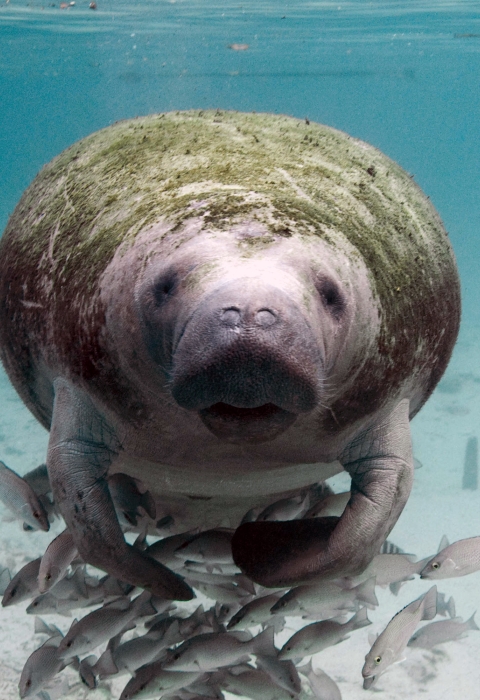Overview
The West Indian manatee is a large, aquatic mammal. There are two subspecies of West Indian manatees: the Antillean manatee (Trichechus manatus manatus) and the Florida manatee (Trichechus manatus latirostris). Due to their eating habits, manatees are nicknamed sea cows, because they eat seagrasses and other aquatic plants.
Manatees are protected under the Endangered Species Act and under the Marine Mammal Protection Act.
Today, the range-wide population is estimated to be at least 13,000 manatees, with more than 6,500 in the southeastern United States and Puerto Rico. When aerial surveys began in 1991, there were an estimated 1,267 manatees in Florida. Today there are more than 6,300 in Florida, representing a significant increase over the past 25 years.
Scientific Name
Identification Numbers
Characteristics
Physical Characteristics
Manatees are typically greyish brown in color. They have sparse hairs spread across their bodies, with bristles about the muzzle.
Manatees are large, elongated marine mammals with paired flippers and a large, spoon-shaped tail. They can reach lengths of more than 14 feet.
Manatees can weigh more than 3,000 pounds.
Habitat
Manatees live in marine, brackish and freshwater systems in coastal and riverine areas throughout their range. Preferred habitats include areas near the shore featuring underwater vegetation like seagrass and eelgrass. They feed along grass bed margins with access to deep water channels, where they flee when threatened. Florida manatees can be found throughout Florida for most of the year. However, they cannot tolerate temperatures below 68 degrees Fahrenheit for extended periods of time, and during the winter months these cold temperatures keep the population concentrated in peninsular Florida. Many manatees rely on the warm water from natural springs and power plant outfalls.
During the summer manatees expand their range, and on rare occasions are seen as far north as Massachusetts on the Atlantic coast and as far west as Texas on the Gulf coast. Manatees may travel hundreds of miles during a year’s time, preferring to travel along channels and shorelines.
Having to do with water
Geography
Historically, West Indian manatees were found along the U.S. Atlantic and Gulf of Mexico coasts, throughout the Caribbean and as far south as Brazil’s Atlantic coastline. However, due to hunting, habitat fragmentation and loss and other factors, manatees have disappeared from various parts of their range. For example, manatee hunts were common until the early 1900s, and as a result the species is no longer found in Guadeloupe and other islands in the Lesser Antilles.
Today manatees are found in the southeastern U.S., eastern Mexico, Guatemala, Belize, Honduras, Costa Rica, Panamá, Nicaragua, Colombia, Venezuela, Guyana, Suriname, French Guiana, Brazil, Trinidad and Tobago, Jamaica, Cuba, Haiti, the Dominican Republic, Puerto Rico and in the Bahamas.
Timeline
Explore the information available for this taxon's timeline. You can select an event on the timeline to view more information, or cycle through the content available in the carousel below.
55 Items